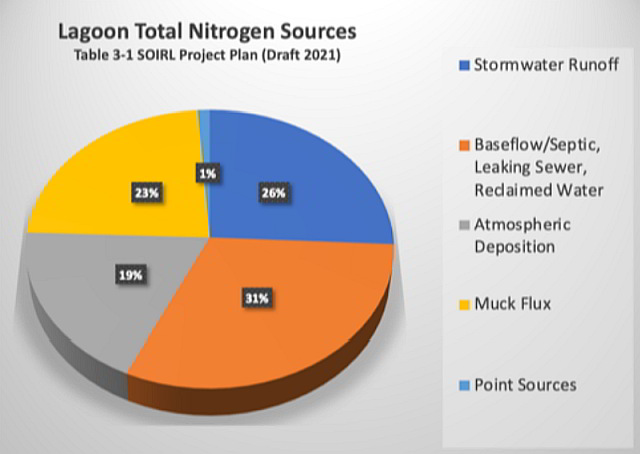IRLNews:Lagoon Restoration: A “Yes And” Issue
Some are complex: The Lagoon water has too much Nitrogen (nutrients) in it causing blooms and fish kills.
Look at the pie chart. There are at least four major contributors. Let’s look at each individually.
Stormwater Runoff: Rain and irrigation runoff. We can help by following watering schedules. The Save Our Indian River Lagoon (SOIRL) Trust Fund plan is tackling stormwater runoff by constructing baffle boxes and retention ponds to slow the drainage and clean the water of nutrients.
Baseflow: Water moving through the ground. The SOIRL plan is connecting leaky Septic Systems close to the water into sewer lines. It is also helping to locate and fix Leaking Sewer lines and is underwriting projects to lower the nitrogen concentration of nutrients in Reclaimed Water.
Atmospheric Deposition is harder to deal with (except that washed off the land by stormwater). Muck Flux is the continual flow of nutrients seeping out of the black goo that coats much of the Lagoon bottom. This goop is the result of 50 years of abuse: sewage plant effluent, silt, grass clippings, dead algae, etc. Every day, every minute it liberates more contaminants. The SOIRL plan is dredging out the major accumulations, extracting and cleaning the water and disposing of it in lined landfills.
This leaves the sliver, Point Sources. Until 1995 this was a major source as sewage plants dumped their effluent directly into the Lagoon but since then they stopped and it has become a minor contributor. Yes, sewage leaks are WRONG and should not be allowed. Utilities have an obligation to maintain their systems to prevent spills. If the utilities cannot afford to do this, they need to bump up their rates so they can.
But back to the beginning: Lagoon Restoration is a complex issue. Every part needs to be addressed—It’s a classic “Yes And” Issue.
Learn more at: HelpTheLagoon.org

